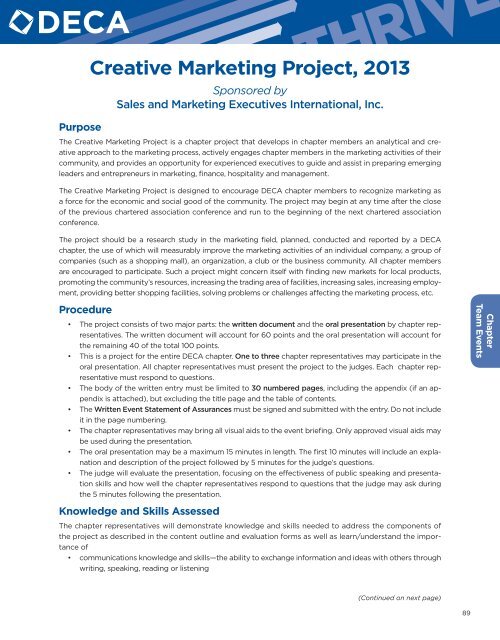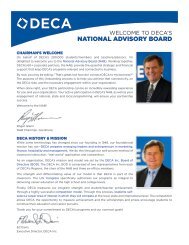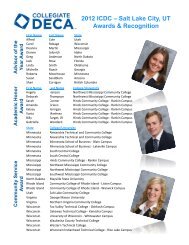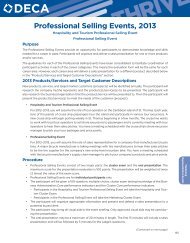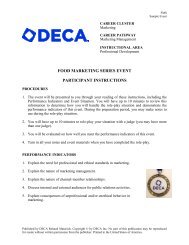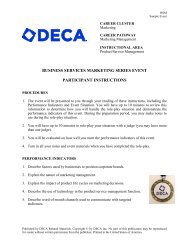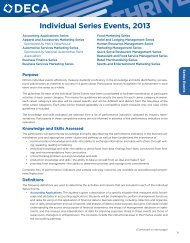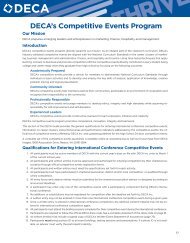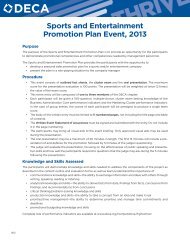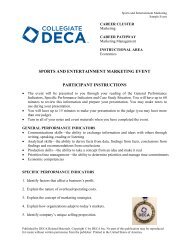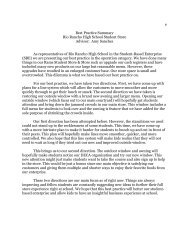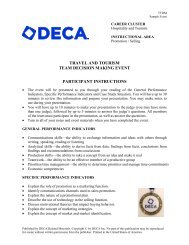Creative Marketing Project, 2013 - DECA
Creative Marketing Project, 2013 - DECA
Creative Marketing Project, 2013 - DECA
Create successful ePaper yourself
Turn your PDF publications into a flip-book with our unique Google optimized e-Paper software.
Purpose<br />
<strong>Creative</strong> <strong>Marketing</strong> <strong>Project</strong>, <strong>2013</strong><br />
Sponsored by<br />
Sales and <strong>Marketing</strong> Executives International, Inc.<br />
The <strong>Creative</strong> <strong>Marketing</strong> <strong>Project</strong> is a chapter project that develops in chapter members an analytical and creative<br />
approach to the marketing process, actively engages chapter members in the marketing activities of their<br />
community, and provides an opportunity for experienced executives to guide and assist in preparing emerging<br />
leaders and entrepreneurs in marketing, finance, hospitality and management.<br />
The <strong>Creative</strong> <strong>Marketing</strong> <strong>Project</strong> is designed to encourage <strong>DECA</strong> chapter members to recognize marketing as<br />
a force for the economic and social good of the community. The project may begin at any time after the close<br />
of the previous chartered association conference and run to the beginning of the next chartered association<br />
conference.<br />
The project should be a research study in the marketing field, planned, conducted and reported by a <strong>DECA</strong><br />
chapter, the use of which will measurably improve the marketing activities of an individual company, a group of<br />
companies (such as a shopping mall), an organization, a club or the business community. All chapter members<br />
are encouraged to participate. Such a project might concern itself with finding new markets for local products,<br />
promoting the community’s resources, increasing the trading area of facilities, increasing sales, increasing employment,<br />
providing better shopping facilities, solving problems or challenges affecting the marketing process, etc.<br />
Procedure<br />
• The project consists of two major parts: the written document and the oral presentation by chapter representatives.<br />
The written document will account for 60 points and the oral presentation will account for<br />
the remaining 40 of the total 100 points.<br />
• This is a project for the entire <strong>DECA</strong> chapter. One to three chapter representatives may participate in the<br />
oral presentation. All chapter representatives must present the project to the judges. Each chapter representative<br />
must respond to questions.<br />
• The body of the written entry must be limited to 30 numbered pages, including the appendix (if an appendix<br />
is attached), but excluding the title page and the table of contents.<br />
• The Written Event Statement of Assurances must be signed and submitted with the entry. Do not include<br />
it in the page numbering.<br />
• The chapter representatives may bring all visual aids to the event briefing. Only approved visual aids may<br />
be used during the presentation.<br />
• The oral presentation may be a maximum 15 minutes in length. The first 10 minutes will include an explanation<br />
and description of the project followed by 5 minutes for the judge’s questions.<br />
• The judge will evaluate the presentation, focusing on the effectiveness of public speaking and presentation<br />
skills and how well the chapter representatives respond to questions that the judge may ask during<br />
the 5 minutes following the presentation.<br />
Knowledge and Skills Assessed<br />
The chapter representatives will demonstrate knowledge and skills needed to address the components of<br />
the project as described in the content outline and evaluation forms as well as learn/understand the importance<br />
of<br />
• communications knowledge and skills—the ability to exchange information and ideas with others through<br />
writing, speaking, reading or listening<br />
(Continued on next page)<br />
89<br />
Chapter<br />
Team Events
CMP–<strong>2013</strong><br />
90<br />
• analytical knowledge and skills—the ability to derive facts from data, findings from facts, conclusions from<br />
findings and recommendations from conclusions<br />
• critical thinking/problem-solving knowledge and skills<br />
• production knowledge and skills—the ability to take a concept from an idea and make it real<br />
• teamwork—the ability to plan, organize and conduct a group project<br />
• the ability to evaluate group presentations<br />
• priorities/time management—the ability to determine priorities and manage time commitments and<br />
deadlines<br />
Format Guidelines for the Written Entry<br />
The written entry must follow these specifications. Refer also to the Written Entry Checklist and the Written<br />
Entry Evaluation Form. A Written Event Statement of Assurances must be signed and submitted with the entry.<br />
Do not include it in the page numbering.<br />
Title page. The first page of the written entry is the title page. It must include in any order, but is not limited to,<br />
the following:<br />
CREATIVE MARKETING PROJECT<br />
Title of the project (for example, “Improving Access to the Smithville Mall”)<br />
Name of <strong>DECA</strong> chapter<br />
Name of high school<br />
School address<br />
City, State/Province, ZIP/Postal Code<br />
Names of chapter representatives<br />
Date<br />
The title page will not be numbered.<br />
Table of contents. The table of contents should follow the title page. All activities or original research described<br />
in this entry must take place between the immediate past International Career Development Conference and<br />
the upcoming Chartered Association Career Development Conference. The table of contents may be singlespaced<br />
and may be one or more pages long. The table of contents page(s) will not be numbered.<br />
Body of the written entry. The body of the written entry begins with Section I, Executive Summary, and continues<br />
in the sequence outlined here. The first page of the body is numbered 1 and all following pages are numbered<br />
in sequence. Page numbers continue through the bibliography (required) and the appendix (optional).<br />
Follow this outline when you write your entry. Points for each section are included on the Written Entry Evaluation<br />
Form. Each section must be titled, including the bibliography and the appendix.<br />
I. EXECUTIVE SUMMARY<br />
One-page description of the project<br />
II. INTRODUCTION<br />
A. Statement of problem<br />
B. Significance of the problem studied<br />
C. Background information: description of the business, community situation or whatever is<br />
necessary to understand the value of the project<br />
III. PROCEDURES AND RESEARCH METHODS USED<br />
A. Description of secondary (library) research conducted: books, articles and other sources<br />
on market research, local descriptive data, etc.<br />
B. Description of primary research conducted<br />
C. Description of involvement of chapter members and businesspeople in the project
IV. FINDINGS AND CONCLUSIONS<br />
A. Presentation of findings, data to support findings<br />
B. Presentation of conclusions, rationale to support conclusions<br />
V. RECOMMENDATIONS<br />
A. Recommendations resulting from the study<br />
B. <strong>Project</strong>ed outcomes from implementing the recommendations<br />
C. Plan for implementing the recommendations<br />
D. Evidence that the project has been presented to the appropriate business and/or<br />
government officials who would benefit from the study<br />
VI. BIBLIOGRAPHY<br />
VII. APPENDIX<br />
An appendix is optional. Include in the appendix any exhibits appropriate to the written entry but<br />
not important enough to include in the body. These might include sample questionnaires used, letters<br />
sent and received, general background data, minutes of meetings, etc.<br />
Checklist Standards<br />
In addition to following the outline provided, when preparing your written entry you must observe all of the following<br />
rules. The purpose of these rules is to make competition as fair as possible among the participant teams.<br />
Refer to the Written Entry Checklist.<br />
1. The Written Event Statement of Assurances must be signed and submitted with the entry or the entry will<br />
receive 15 penalty points.<br />
2. The entry must be submitted in an official <strong>DECA</strong> written event folio. Folios are available from <strong>DECA</strong> IM-<br />
AGES (FOLIO). No markings, tape or other material should be attached to the folio. One photocopy or<br />
the original typed document must be submitted. Chapter representatives may keep a copy for use in the<br />
presentation.<br />
3. Sheet protectors may not be used.<br />
4. The body of the written entry must be limited to 30 numbered pages, including the appendix (if an appendix<br />
is attached), but excluding the title page and the table of contents page.<br />
5. The pages must be numbered in sequence, starting with the executive summary and ending with the final<br />
page of the appendix. Do not use separate sheets between sections or as title pages for sections.<br />
6. Major content of the written entry must be at least double-spaced (not space-and-a-half). The title page,<br />
table of contents, executive summary, bibliography, appendix, footnotes, long quotes (more than three<br />
typed lines), material in tables, figures, exhibits, lists, headings, sample letters, forms, etc., may be singlespaced.<br />
7. Entry must be typed/word processed. Handwritten corrections will be penalized. Charts and graphs<br />
may be handwritten. (Judges will be instructed to ignore attempts to achieve a competitive advantage<br />
due to the quality of word-processing equipment available.)<br />
8. All material must be shown on 8 1 /2-inch x 11-inch paper. Pages may not fold out to a larger size. No extraneous<br />
information may be attached to the pages and tabs may not be used.<br />
9. The written entry must follow the format guidelines. Additional subsections are permitted in the body of<br />
the written entry.<br />
Presentation Guidelines<br />
• Prior to the presentation, the judge will evaluate the written portion of the entry. The major emphasis of<br />
the written entry is on the content. Drawings, illustrations and graphic presentations (where allowed) will<br />
be judged for clarity, not artistic value.<br />
• The chapter representatives will present the project to the judge in a 15-minute presentation worth 40<br />
points. (See Presentation Judging.)<br />
• The presentation begins immediately after the introduction of the chapter representatives to the judge by<br />
(Continued on next page)<br />
CMP–<strong>2013</strong><br />
91<br />
Chapter<br />
Team Events
CMP–<strong>2013</strong><br />
92<br />
the adult assistant. Each chapter representative must take part in the presentation.<br />
• The chapter representatives will spend not more than 10 minutes, at the beginning of the presentation,<br />
focusing on an explanation and description of the chapter’s project. Each chapter representative may<br />
bring a copy of the written entry or note cards pertaining to the written entry and use as reference during<br />
the presentation.<br />
• The judge will spend the remaining 5 minutes questioning the chapter representatives. (See Presentation<br />
Evaluation Form.) Each chapter representative must respond to at least one question posed by the judge.<br />
• The chapter representatives may use the following items during the oral presentation:<br />
– not more than three (3) standard-sized posters not to exceed 22 1 /2 inches by 30 1 /2 inches each. Participants<br />
may use both sides of the posters, but all attachments must fit within the poster dimensions.<br />
– one (1) standard-sized presentation display board not to exceed 36 1 /2 inches by 48 1 /2 inches.<br />
– one (1) desktop flip chart presentation easel 12 inches by 10 inches (dimensions of the page).<br />
– one (1) personal laptop computer.<br />
– cell phones/smartphones, iPods/MP3 players, iPads/tablets or any type of a hand-held, information<br />
sharing device will be allowed in written events if applicable to the presentation.<br />
– sound, as long as the volume is kept at a conversational level.<br />
• Only visual aids that can be easily carried to the presentation by the actual chapter representatives will<br />
be permitted, and the chapter representatives themselves must set up the visuals. No set-up time will be<br />
allowed. Chapter representatives must furnish their own materials and equipment. No electrical power will<br />
be supplied.<br />
• Materials appropriate to the situation may be handed to or left with judges in all competitive events. Items<br />
of monetary value may be handed to but may not be left with judges. Items such as flyers, brochures,<br />
pamphlets and business cards may be handed to or left with the judge. No food or drinks allowed.<br />
• If any of these rules are violated, the adult assistant must be notified by the judge.<br />
Presentation Judging<br />
Chapter representatives will make a 15-minute presentation to you. Remember, you are role-playing the manager<br />
who gave the chapter representatives the task of preparing this proposal. You may refer to the written<br />
entry, or to your notes, during the presentation.<br />
During the first 10 minutes of the presentation (after introductions), the chapter representatives will describe<br />
the project. Allow the chapter representatives to complete this portion without interruption, unless you are<br />
asked to respond. Each chapter representative must take part in the presentation.<br />
During the final 5 minutes, you may question the chapter representatives. You must address at least one question<br />
to each chapter representative. To ensure fairness, you must ask each chapter representative or group of<br />
chapter representatives the same three questions (based on the Presentation Evaluation Form):<br />
1. one question on the rationale for selecting the problem<br />
2. one question on the rationale for the design of the research<br />
3. one question on the findings and recommendations<br />
These questions should be prepared following the written entry evaluation but before the presentation<br />
begins.<br />
After asking the three questions, you may ask additional questions that seem appropriate, based on your notes<br />
or on the written entry itself (to which you may refer during the presentation).<br />
At the conclusion of the presentation, thank the chapter representatives. Then complete the Presentation Evaluation<br />
Form, making sure to record a score for all categories. Maximum score for the presentation is 40 points.
<strong>Creative</strong> <strong>Marketing</strong> <strong>Project</strong>, <strong>2013</strong> Participant(s): ____________________________________<br />
Written Entry Evaluation Form I.D. Number: _____________________________________<br />
EXECUTIVE SUMMARY<br />
Please refer to Format Guidelines for the Written Entry<br />
for a more detailed explanation of these items.<br />
Little/No Below Meets Exceeds Judged<br />
Value Expectations Expectations Expectations Score<br />
1. One-page description of the project.............................................. 0-1 2 3 4 ____<br />
INTRODUCTION<br />
2. Problem is stated clearly ...................................................................... 0-1 2 3 4 ____<br />
3. Significance of the problem studied .............................................. 0-1 2 3 4 ____<br />
4. Appropriate background information<br />
is provided ................................................................................................... 0-1 2 3 4 ____<br />
PROCEDURES AND RESEARCH METHODS USED<br />
5. Description of secondary<br />
research conducted ................................................................................ 0-1 2 3 4 ____<br />
6. Description of primary<br />
research conducted ................................................................................ 0-1 2 3 4 ____<br />
7. Description of the involvement of<br />
chapter members and businesspeople ......................................... 0-1 2 3 4 ____<br />
FINDINGS AND CONCLUSIONS<br />
8. Presentation of findings ........................................................................ 0-1 2-3 4 5-6 ____<br />
9. Presentation of conclusions ................................................................ 0-1 2-3 4 5-6 ____<br />
RECOMMENDATIONS<br />
10. Recommendations resulting from the study .............................. 0-1 2 3 4 ____<br />
11. <strong>Project</strong>ed outcomes from the implementation ......................... 0-1 2 3 4 ____<br />
12. Plan for implementing the<br />
recommendations .................................................................................... 0-1 2 3 4 ____<br />
13. <strong>Project</strong> presented to the<br />
appropriate officials ................................................................................ 0-1 2 3 4 ____<br />
APPEARANCE AND WORD USAGE<br />
14. Professional layout, neatness, proper grammar,<br />
spelling and word usage ....................................................................... 0-1 2 3 4 ____<br />
Written Entry Total Points (maximum 60 points): ____<br />
Judge: A B C D E F G H I J (circle one)<br />
CMP–<strong>2013</strong><br />
93<br />
Chapter<br />
Team Events
94<br />
<strong>Creative</strong> <strong>Marketing</strong> <strong>Project</strong>, <strong>2013</strong> Participant(s): ____________________________________<br />
Oral Presentation Evaluation Form I.D. Number: _____________________________________<br />
Little/No Below Meets Exceeds Judged<br />
Value Expectations Expectations Expectations Score<br />
1. Opening presentation: description of the project;<br />
organization, clarity and effectiveness of<br />
the presentation ........................................................................................ 0-1 2-3-4 5-6 7-8 ____<br />
2. Question on the rationale for selecting<br />
the research problem ............................................................................. 0-1 2-3-4 5-6 7-8 ____<br />
3. Question on the rationale for the design<br />
of the research ........................................................................................... 0-1 2-3-4 5-6 7-8 ____<br />
4. Question on the findings and<br />
recommendations .................................................................................... 0-1 2-3-4 5-6 7-8 ____<br />
5. To what extent did the chapter representatives<br />
demonstrate professional appearance,<br />
poise and confidence? ........................................................................... 0-1 2 3 4 ____<br />
6. Overall performance, presentation technique,<br />
effective use of visuals and participation of all ......................... 0-1 2 3 4 ____<br />
Presentation Total Points (maximum 40 points): ____<br />
RECAP: WRITTEN ENTRY (60): ____<br />
Judge: A B C D E F G H I J (circle one)<br />
PRESENTATION (40): ____<br />
SUBTOTAL (100): ____<br />
LESS PENALTY POINTS: ____<br />
TOTAL SCORE: ____<br />
CMP–<strong>2013</strong>


